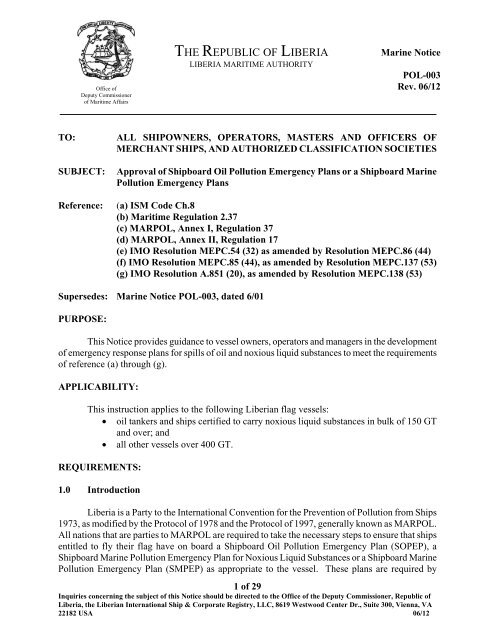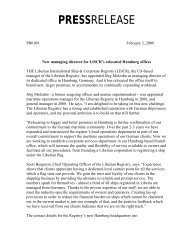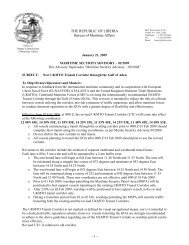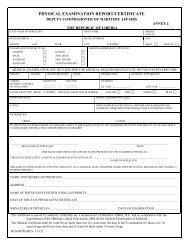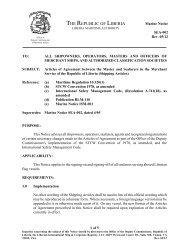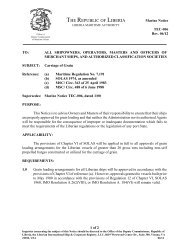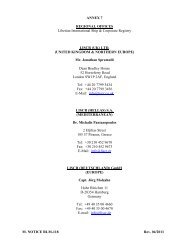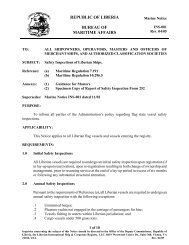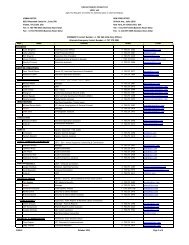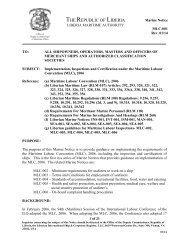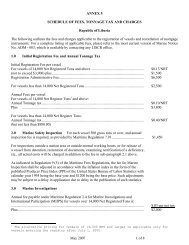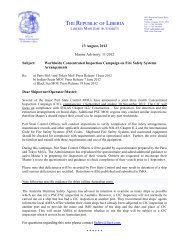Create successful ePaper yourself
Turn your PDF publications into a flip-book with our unique Google optimized e-Paper software.
4.3 Communication:4.3.1 The ship involved in oil or noxious liquid substance pollution incident will have tocommunicate with both coastal State or port contacts and ship interest contacts.4.3.2 When compiling contact lists, due account must be taken of the need to provide 24-hourcontact information and to provide alternates to the designated contact. These details must beroutinely updated to account for personnel changes and changes in telephone, telex, andtelefax numbers. The preferred means of communication (E-mail, telex, telephone, telefax,etc.) should be identified.4.3.3 Coastal State contacts:.1 To expedite response and minimize damage from an oil or noxious liquid substancepollution incident, the coastal States should be notified without delay. The processbegins with the initial report required by article 8 and Protocol I of the Convention.Guidelines for making this report are provided in Resolution A.851 (20) as amended..2 The Plan should include as an appendix the list of agencies or officials of administrationsresponsible for receiving and processing reports as developed and updated by theOrganization in conformance with article 8 of the Convention. An up to date list ofcoastal state spill response contacts is available from IMO by going to the IMO web siteat www.imo.org (Select ‘Circulars/Contact Points’ or ‘National Contacts/Contact Points’at the bottom of the IMO homepage, then select the most current version of the MSC-MEPC.6 Circ.XX Annex II). Changes or amendments to the last release is available ongisis.imo.org/Public. Select ‘Contact Points’, then select ‘Annex 2: Changes andamendments to the last release’. In the absence of such a list, or should any undue delaybe experienced in contacting the responsible authority by direct means, the master shouldbe advised to contact the nearest coastal radio station, designated ship movementreporting station or rescue co-ordination center (RCC) by the quickest available means.4.3.4 Port contacts:.1 For ships in port, notification of local agencies will speed response. The variety of tradesin which ships engage makes it impractical to specify in these Guidelines a definitiveapproach to listing these agencies in the Plan. Information on regularly visited portsshould be included as an appendix to the Plan. Where this is not feasible, the Plan shouldrequire the master to obtain details concerning local reporting procedures upon arriving inport.4.3.5 Ship interest contacts:.1 The Plan should provide details of all parties with an interest in the ship to be advised inthe event of an incident. This information should be provided in the form of a contact list.When compiling such lists, it should be remembered that in the event of a serious incident,ship’s personnel will be fully engaged in life saving and taking steps to control andminimize the effects of the casualty. Therefore, they should not be hampered by havingonerous communications requirements imposed on them.POL-003 5 of 29 Rev. 06/12The Republic of Liberia
(Material Safety Data Sheets, etc), shall identify physical properties of the NLS, specialprotective equipment or unusual response techniques in a format consistent with section3.2 of these guidelines. Reference may be made to Data Sheet or similar documents thatidentify characteristics of NLS. A copy of such document should be kept with the plan,but need not be part of the approved plan. In addition to the checklists, specificpersonnel assignments for anticipated tasks must be identified. Reference to existing firecontrol plans and muster lists is sufficient to identify personnel responsibilities. Thefollowing are examples of casualties, which should be considered:.2.1 grounding;.2.2 fire/explosion;.2.3 collision (with fixed or moving object);.2.4 hull failure;.2.5 excessive list;.2.6 containment system failure;.2.7 dangerous reactions of cargo (for ships certified to carry NLSs);.2.8 other hazardous cargo release (for ships certified to carry NLSs);.2.9 loss of tank environmental control (for ships certified to carry NLSs);.2.10 submerged/foundered;.2.11 wrecked/stranded;.2.12 cargo contamination yielding a hazardous condition (for ships certified tocarry NLSs); and.2.13 hazardous vapor release.4.4.3 In addition to the checklists and personnel duty assignments mentioned in section 4.4.2, thePlan should provide the master with guidance concerning priority actions, personnel safety,stability and stress considerations, and lightening and mitigating activities.4.4.4 Priority actions - This section provides some general considerations that apply to a widerange of casualties. The Plan should provide ship-specific guidance to the master concerningthese broad topics..1 In responding to a casualty, the master’s priority will be to ensure the safety of personneland the ship and to take action to prevent escalation of the incident. In casualtiesinvolving spills, immediate consideration should be given to measures aimed atpreventing fire, personnel exposure to toxic vapors, and explosion, such as alteringcourse so that the ship is up wind of the spilled cargo, shutting down non-essential airintakes, etc. If the ship is aground, and cannot therefore maneuver, all possible sourcesof ignition should be eliminated and action should be taken to prevent toxic vapors orflammable vapors entering accommodation and engine-room spaces. When it is possibleto maneuver, the master, in conjunction with the appropriate shore authorities, mayconsider moving his ship to a more suitable location in order, for example, to facilitateemergency repair work or lightening operations, or to reduce the threat posed to anyparticularly sensitive shoreline areas. Such maneuvering may be subject to coastal Statejurisdiction..2 Prior to considering remedial action, the master will need to obtain detailed informationon the damage sustained by his ship. A visual inspection should be carried out and allcargo tanks, bunker tanks, and other compartments should be sounded. Due regardshould be paid to the indiscriminate opening of ullage plugs or sighting ports, especiallywhen the ship is aground, as loss of buoyancy could result.POL-003 7 of 29 Rev. 06/12The Republic of Liberia
.3 Having assessed the damage sustained by the ship, the master will be in a position todecide what action should be taken to prevent or minimize further discharge. Whenbottom damage is sustained, hydrostatic balance will be achieved (depending on physicalproperties) fairly rapidly, especially if the damage is severe, in which case the timeavailable for preventive action will often be limited. When significant side damage issustained in the way of fuel, lubrication, or cargo tanks, bunkers or cargo will be releasedfairly rapidly until hydrostatic balance is achieved and the rate of release will then reduceand be governed by the rate at which bunkers or cargo is displaced by water flowing inunder the bunkers or cargo. When the damage is fairly limited and restricted, forexample, to one or two compartments, consideration may be given to transferring thesubstance involved internally from damaged to intact tanks. When considering thetransfer of oil or noxious liquid substances from a damaged tank to an intact tank, themaster should consider:.1 the extent of the damage;.2 hydrostatic balance;.3 the ship’s ability to transfer cargo safely; and.4 the physical properties of the substance(s) (for ships certified to carryNLSs) involved such as:.1 solubility;.2 density;.3 water reactivity;.4 solidification; and.5 compatibility.4.4.5 Stability and strength considerations - Great care in casualty response must be taken toconsider stability and strength when taking actions to mitigate the spillage of oil or noxiousliquid substance or to free the ship if aground. The Plan should provide the master withdetailed guidance to ensure that these aspects are properly considered. This section shall notbe construed as creating a requirement for damage stability plans or calculations beyondthose required by relevant international conventions..1 Internal transfers should be undertaken only with a full appreciation of the likely impacton the ship’s overall longitudinal strength and stability. When the damage sustained isextensive, the impact of internal transfers on stress and stability may be impossible forthe ship to assess. Contact may have to be made with the owner or operator or otherentity in order that adequate information can be provided so that accurate damagestability and damage longitudinal strength assessments may be made. These could bemade within the head office technical departments. In other cases, classificationsocieties or independent organizations may need to be contacted. The Plan shouldclearly indicate whom the master should contact to acquire this assistance. Additionally,in the case of ships certified to carry NLSs, consideration as to the compatibility of allsubstances involved such as cargoes, bunkers, tanks, coatings, piping, etc., must also beconsidered before such an operation is undertaken..2 The Plan should provide a list of the information required to make damage stability anddamage longitudinal strength assessments possible for the Master to provide to thecontact points who will provide the appropriate assistance.4.4.6 Lightening - Should the ship sustain extensive structural damage, it may be necessary totransfer all or part of the cargo to another ship. The Plan should provide guidance onPOL-003 8 of 29 Rev. 06/12The Republic of Liberia
procedures to be followed for ship-to-ship transfer of cargo. Reference may be made in thePlan to existing company guides. A copy of such company procedures for ship-to-shiptransfer operations should be kept with the Plan. The Plan should address the need for cocoordinatingthis activity with the coastal State; as such operation may be subject to thecoastal state’s jurisdiction.4.4.7 Mitigating activities - When the safety of both the ship and personnel has been addressed, themaster can initiate mitigating activities according to the guidance given by the plan. The planshall address such aspects as:.1 assessment and monitoring requirements;.2 personnel protection issues:.1 protective equipment; and.2 threats to health and safety..3 physical properties of the substance (for ships certified for NLSs) involved such as:.1 solubility;.2 density;.3 water reactivity;.4 solidification; and.5 compatibility.4 containment and other response techniques (e.g. dispersing, absorbing,neutralization);.5 isolation procedures;.6 decontamination of personnel; and.7 disposal of removed oil, noxious liquid substances and clean-up materials.4.4.8 In order to have the necessary information available to respond to the situations, certainplans, drawings, and ship-specific details such as, a layout of a general arrangement plan, atank plan, etc., should be appended. The Plan should show where current cargo, bunker andballast information, including quantities and specifications, are available.4.5 National and local co-ordination - Quick, efficient co-ordination between the ship andcoastal State or other involved parties becomes vital in mitigating the effects of an oil ornoxious liquid substances pollution incident. The Plan should address the need to contact thecoastal State for authorization prior to undertaking mitigating actions.4.5.1 The identities and roles of various national and local authorities involved vary widely fromState to State and even from port to port. Approaches to responsibility for dischargeresponse also vary. Some coastal States have agencies that take charge of responseimmediately and subsequently bill the owner for the cost. In other coastal States,responsibility for initiating response is placed on the shipowner. In the case of the latter thePlan will require greater detail and guidance to assist the master in organizing this response.5.0 NON-MANDATORY PROVISIONS5.1 Owner/operator policies: In addition to the provisions required by regulation 37 of Annex Iand/or regulation 17 of Annex II of the Convention, local requirements, insurance company,or owner/operator policies, etc., may dictate that other guidance be provided in the Plan.These topics may include: provision of diagrams and drawings; ship-carried responseequipment; public affairs; record keeping; product specific response information (for shipscertified to carry NLSs) and reference materials.POL-003 9 of 29 Rev. 06/12The Republic of Liberia
5.2 Plans and diagrams: In addition to the plans required by paragraph 4.4.6 above, otherdetails concerning the ship’s design and construction may be appended to the Plan or theirlocation identified.5.3 Response equipment: Some ships may carry on board equipment to assist in pollutionresponse. The type and quantity of this equipment may vary widely. The Plan shouldindicate an inventory of such equipment, if carried. It should also provide directions for safeuse and guidelines to assist the master in determining when such use is warranted. Careshould be exercised to ensure that the use of such equipment by the crew is practical andconsistent with safety considerations. When such equipment is carried, the Plan shouldestablish personnel responsibilities for its deployment, oversight, and maintenance. In orderto ensure safe and effective use of such equipment, the Plan should also provide for crewtraining in the use of it. The Plan should include a provision that no chemical agent shouldbe used for response to pollution on the sea without authorization of the appropriate coastalState and that such authorization should also be requested, when required, for use ofcontainment or recovery equipment.5.4 Shore-side Spill Response Co-coordinator or Qualified Individual: Guidance to themaster for requesting and co-coordinating initial response actions with the person responsiblefor mobilizing shore side response personnel and equipment.5.5 Coastal State Requirements: Some coastal States require ships to have contracts with“response contractors.” When ships sail toward such States, it is recommended that responseresources (personnel and equipment) and capabilities be identified in advance for eachpotential port State. In other States, the response equipment is identified by the coastal Stateand they direct the response.5.6 Planning Standards: To facilitate forethought about the amount of response resources,which should be requested, possible scenarios should be analyzed and planned foraccordingly.5.7 Public affairs: The owners may want to include in the Plan guidance for the master indealing with the distribution of information to the news media. Such guidance should befashioned to reduce the burden on ship’s personnel already busy with the emergency at hand.5.8 Record-keeping: As with any other incident that will eventually involve liability,compensation and reimbursement issues, the owner may want to include in his Plan guidancefor the keeping of appropriate records of the oil or noxious liquid substances pollutionincident. Apart from detailing all actions taken on board, records might includecommunications with outside authorities, owners, and other parties, as well as a briefsummary of decisions and information passed and received. Guidance on collecting ofsamples of spilled oil or noxious liquid substance as well as that carried on board may also beprovided.5.9 Plan review: Regular review of the Plan by the owner, operator or master is recommendedto ensure that the specific information is current. A feedback system should be employed toallow quick capture of changing information and incorporation of it into the Plan. Thisfeedback system should incorporate the following:.1 Periodic review - The Plan should be reviewed by the owner or operator at least yearly toPOL-003 10 of 29 Rev. 06/12The Republic of Liberia
capture changes in local law or policy, contact names and numbers, ship characteristics,or company policy..2 Event review - After any use of the Plan in response to an incident, its effectivenessshould be evaluated by the owner or operator and modifications made accordingly.5.10 Plan testing: The Plan will be of little value if it is not made familiar to the personnel whowill use it. Regular exercises will ensure that the Plan functions as expected and that thecontacts and communications specified are accurate. Such exercises should be held inconjunction with other shipboard exercises and appropriately logged. Where ships carryresponse equipment, hands-on experience with it by crewmembers will greatly enhancesafety and effectiveness in an emergency situation. Procedures for training and exerciseshould be defined.5.11 Salvage: The plan should contain information on what the crew’s responsibilities are in acasualty where a vessel is partially or fully disabled, and what constitutes dangerousconditions. A decision process should be outlined in the plan that will aid the master indetermining when salvage assistance should be obtained. The decision process shouldinclude, but not be limited to the following:.1 Nearest land or hazard to navigation;.2 Vessel set and drift;.3 Location and time of impact with hazard based on vessel set and drift;.4 Estimated time of casualty repair; and.5 Determination of the nearest capable assistance and its response time (i.e. for tugassistance, the time it will take to get on scene and secure the tow). When a casualtyoccurs to a vessel underway which reduces its maneuverability, the master needs todetermine his window of opportunity considering the response time of assistance,regardless of the estimated time of repair. It is not prudent to hesitate in calling forassistance when the time needed to repair something goes beyond the window ofopportunity.POL-003 11 of 29 Rev. 06/12The Republic of Liberia
6.0 ATTACHMENTS AND APPENDIXES6.1 Appendixes: It is envisioned that a notebook or small binder be used for this Plan as thenumerous Appendixes should be arranged for easy use by shipboard personnel and to easeupdating. Appendixes should include at least:- IMO Resolution A851 (20) as amended by Resolution MEPC.138 (53)- Listing of Coastal State Agencies or Officials- Listing of Regional or Port Authorities- Listing of Ship Interest Contacts- Listing of Shore-based Spill Response Contractors- Listing of Shore-based Technical Advisors- Ship’s plans and drawings- Summary flowchart (consideration should be given to adapting the flowchart for bulkheaddisplay on board.)6.2 Review of appendixes: The data contained in the Appendices shall be routinely reviewedand updated as necessary. Updates to the Appendices may be done without the Office of theDeputy Commissioner's approval.* * * * *POL-003 12 of 29 Rev. 06/12The Republic of Liberia
APPENDIX IAdditional references for the development of shipboard marine pollution emergency plansThe following publications are suggested to provide additional assistance in the preparation ofPlans:Manual on Oil Pollution, Section II, Contingency PlanningInternational Maritime Organization (IMO)ISBN 978-92-801-13303Available in English from IMO Publications Section,4 Albert Embankment, London SEI 7SR, United KingdomProvisions Concerning the Reporting of Incidents Involving Harmful Substances underMARPOL 73/78Available in English from IMOISBN 978-92-801-60987Manual on Chemical Pollution (Section 1 - Problem assessment and response arrangements)Available in English, French and Spanish from IMOISBN 978-92-801-60963IMDG Code Supplement (Emergency Response Procedures Guide -EMS + Medical First AidGuide for use in accidents involving dangerous goods-MFAG + Reporting Procedures)Available in English, French, and Spanish from IMOISBN 978-92-801-15147International Code for the Construction and Equipment of Ships carrying Dangerous Chemicalsin Bulk (IBC) CodeAvailable in English, French and Spanish from IMOISBN 978-92-801-42266Code for the Construction and Equipment of Ships carrying Dangerous Chemicals in Bulk(BCH) CodeAvailable in English from IMOISBN 978-92-801-15093International Safety Management Code (ISM Code) and Guidelines on Implementation of theISM CodeAvailable in English, French and Spanish from IMOISBN 978-92-801-51510POL-003 13 of 29 Rev. 06/12The Republic of Liberia
Guidelines for the Development of Shipboard Marine Pollution Emergency PlansAvailable in English, French and Spanish from IMOISBN 978-92-801-15185Response to Marine Oil SpillsInternational Tanker Owners Pollution Federation (ITOPF)ISBN 9781856093545Available in English and Spanish from Witherby Seamanship International,4 Dunlop Square, Deans Estate, Livingston,EH54 8SB, United KingdomInternational Safety Guide for Oil Tankers and Terminals (ISGOTT)International Chamber of Shipping and Oil Companies International Marine Forum(ICS/OCIMF)Available from Witherby Seamanship InternationalISBN 9781856092913Peril at Sea and Salvage -- A Guide for MastersICS/OCIMFAvailable from Witherby Seamanship InternationalISBN 9781856090957Ship-to-Ship Transfer Guide (Petroleum)ICS/OCIMFAvailable from Witherby Seamanship InternationalISBN 9781856092586Tanker Safety Guide (Chemicals)ICSAvailable from Marisec Publications, 12 Carthusian Street,London EC1M 6EB, United KingdomShip-to-Ship Transfer Guide (Liquefied Gases)ICS/OCIMF/SIGTTOAvailable from Witherby Seamanship InternationalISBN 1 85609 0825Model <strong>SOPEP</strong> & <strong>SMPEP</strong>International Chamber of Shipping (ICS), 12 Carthusian Street, London EC I M 6EB, UnitedKingdomU.S. Code of Federal Regulations, Title 46, Part 150, Compatibility of Cargoes Available fromSuperintendent of Documents, Government Printing Office, Washington, DC 20402, UnitedStatesChemical Hazards Response Information System (CHRIS) Hazardous Data Manual Availablefrom Superintendent of Documents, Government Printing Office, Washington, DCPOL-003 14 of 29 Rev. 06/12The Republic of Liberia
APPENDIX IIMODEL <strong>SOPEP</strong> or <strong>SMPEP</strong>INTRODUCTION1. This Plan is written in accordance with the requirements of Regulation 37 of Annex Iand/or17 of Annex II of the International Convention for the Prevention of Pollution fromShips, 1973, as modified by the Protocol of 1978 and 1997 relating thereto.2. The purpose of this Plan is to provide guidance to the master and officers on board this shipwith respect to the steps to be taken when a pollution incident has occurred or is likely tooccur.3. This Plan contains all information and operational instructions required by the guidelines.The appendices contain names, telephone; telex numbers, etc., of all contacts referenced inthis Plan, as well as other reference material.4. This Plan has been approved by the Administration and, except as provided below, noalteration or revision shall be made to any part of it without the prior approval of the Officeof the Deputy Commissioner.5. Changes to Section 5 and the appendices will not be required to be approved by the Office ofthe Deputy Commissioner. The appendices should be maintained up to date by the owners,operators and managers.POL-003 15 of 29 Rev. 06/12The Republic of Liberia
SHIPBOARD MARINE POLLUTION EMERGENCY PLANFOR THE (NAME AND/OR IMO NUMBER OF SHIP AND PORT OF REGISTRY)INDEX OF SECTIONSSectionTitle1 Preamble2 Reporting Requirements2.1 When to Report2.1.1 Actual discharge2.1.2 Probable discharge2.2. Information Required2.2.1 Additional Notifications2.2.2 Follow-up Reports2.2.3 Information required2.2.4 Message format2.3 Whom to Contact2.3.1 Coastal state contacts2.3.2 Port contacts2.3.3 Ship interest contacts3 Steps to Control Discharge3.1 Operational Spills3.2 Spills Resulting from Casualties3.3 Priority actions3.4 Stability and strength considerations3.5 Lightening3.6 Mitigating activities3.7 Plans & Drawings4 National and Local Co-Ordination4.1 Co-ordination between ship and coastal state authorities4.1 Roles of national and local authorities5 Additional Information (non-mandatory)AppendicesPOL-003 16 of 29 Rev. 06/12The Republic of Liberia
Revised:Section 1: PreambleThis Plan is available to assist shipboard personnel in dealing with an unexpected dischargeof oil or noxious liquid substances. Its primary purpose is to set in motion the necessary actions tosafely stop or minimize the discharge and to mitigate its effects. Effective planning ensures that thenecessary actions are taken in a structured, logical and timely manner.The need for a predetermined and properly structured Plan is clear when one considers thepressures and multiple tasks facing personnel confronted with an emergency situation. In the heat ofthe moment, lack of planning will often result in confusion, mistakes, and failure to advise keypeople. Delays will be incurred and time will be wasted; during which the situation may deterioratefurther. As a consequence, the ship and its personnel may be exposed to increasing hazards andgreater environmental damage may occur.This plan has been developed to address such emergency situations. It is intended to be arealistic practical document, easy to use, and understood by the Master, ship's officers and shore sidemanagement. This Plan is in the working language of the Master and officers; contains proceduresto be followed by the master or other person in charge in reporting an oil pollution incident; includesa description of the actions that should be taken immediately by persons on board to protectthemselves and others from the hazards presented by the chemical released and to reduce or controlthe discharge. The Plan includes procedures for coordinating shipboard activities with coastal,national, and port authorities' response activities.Detailed information regarding the ship or the cargo shall be readily accessible on board butis not required to be maintained as part of this Plan. This Plan shall be maintained on board andmade available for inspection by flag State and port State authorities on demand.POL-003 17 of 29 Rev. 06/12The Republic of Liberia
Section 2: Reporting RequirementsThe requirements for reporting actual and/or probable oil pollution incidents under MARPOL,Annex I, Regulation 37, and Regulation 17 of Annex II are as follows.2.1 A report is required whenever there is:.1 Actual discharge of oil or NLS an actual discharge of oil or NLS resulting from damage to the ship or itsequipment, or for the purpose of securing the safety of a ship or saving life at sea;or an actual discharge of oil or NLS during the operation of the ship in excess of thequantity or instantaneous rate permitted under the present Convention..2 Probable discharge of oil or NLSWhile it is impracticable to provide precise definitions of all types of situations involvingthe probability of a discharge of oil or NLS, the general guideline for making a reportincludes cases of:damage, failure or breakdown which affects the safety of ships; examples of suchsituations are collision, grounding, fire, explosion, structural failure, flooding,cargo shifting; andfailure or breakdown of machinery or equipment which results in impairment ofthe safety of navigation; examples of such incidents are failure or breakdown ofsteering gear, propulsion, electrical generating system, essential ship bornenavigational aids.2.2 Notification of the Coastal State(s) shall be by the most expeditious means available andshould follow the guidelines of IMO Resolution A851(20), as amended by MEPC.138(53),General Principles for Ship Reporting Systems and Ship Reporting Requirements, includingGuidelines for Reporting Incidents Involving Dangerous Goods, Harmful Substances and/orMarine Pollutants (adopted November 27, 1997).The Master, in deciding on the need to report, shall consider at least the following factors:the nature of the damage, failure or breakdown of ship, machinery orequipment;ship location and proximity to land or other navigational hazards;weather, tide, current and sea state; andtraffic density..1 If additional Coastal State(s), regional or port area authorities are known to the Master orvessel owner, additional notifications via appropriate and timely means are encouraged..2 Supplementary or follow-up reports shall be made using this same procedure. Once aninitial report is made, at least one follow-up report will be needed so as to conclude anyfurther activity regarding the reported matter..3 Information required includes:POL-003 18 of 29 Rev. 06/12The Republic of Liberia
- Ship Name, Call Sign, Flag- Date, Time of Event (UTC)- Position- True Course- Speed- Intended Track- Radio stations/frequencies guarded- Time of Next Report- Type and Quantity of Cargo & Bunkers on board- Defect, Deficiencies or Damage Report- Pollution Details (type and amount lost)- Weather & Sea Conditions- Ship's Representative or Owner- Ship size and type- Other Data: Incident details, need for assistance, action being taken, size of crew,injury or fatality report, and so on..4 The Plan's Appendices should include copies of the message format to be used(illustrated in Table 1 below) and Resolution A.851(20) as amended by ResolutionMEPC.138(53) including its Annex, to assist in making this report.2.3 Whom to Contact:.1 Coastal States: for ships at sea, a listing of authorities to be notified as requested throughIMO follows in the Appendices..2 Port Contacts: for ships in port, see the appropriate Appendix for a listing of authoritieswithin the Port where the incident is occurring. Local agent, coast guard or portauthorities should be considered..3 Ship Interest Contacts: as directed by the owner, agent, Administration, P & I clubs, andso forth. Provide a precedent order and complete identification, E-mail, fax, phone andtelex information. The Decision-Maker must be among those kept informed as thatindividual will be the primary liaison with the Office of the Deputy Commissioner.POL-003 19 of 29 Rev. 06/12The Republic of Liberia
TABLE 1SHIPBOARD MARINE POLLUTION EMERGENCY PLAN (FOR OIL AND/ORNOXIOUS LIQUID SUBSTANCES) 1SAMPLE FORMAT FOR INITIAL NOTIFICATIONAA (SHIP NAME, CALL SIGN, FLAG)BB (DATE AND TIME OF EVENT, UTC)D D H H M MCC (POSITION, LAT, LONG) OR DD (BEARING, DISTANCE FROM LANDMARK)N SD D M MD D D M ME WD D D M MEE COURSEFF (SPEED, KNOTS)D D DLL (INTENDED TRACK)MM (RADIO STATIONS GUARDED)NN (date and time of next report , UTC)kn kn 1/10D D H H M MPP (TYPE AND QUANTITY OF CARGO/BUNKERSON BOARD- ESPECIALLY INFORMATION REGARDINGDANGEROUS CARGOS):QQ(BREIEF DETAILS OF DEFECTS, DAMAGE DEFICIENCIES, LIMITATIONS):RR (BRIEF DETAILS OF POLLUTION, DANGEROUS GOODS LOST OVERBAORD: POSITION, ASEXPRESSED IN CC AND DD ABOVE:SS (BRIEF DETAILS OF WEATHER AND SEA CONDITIONS):WINDDIRECTIONSWELLDIRECTIONSPEED (BEAUFORT) HEIGHT (M)TT (CONTACT DETAIL OF SHIP’S OWNER/OPERATOR/AGENT):UU (SHIP SIZE AND TYPE)LENGTH: (m) BREADTH: (m) DRAUGHT: (m) TYPE:XX (ADDITIONAL INFORMATION):BREIEF DETAILS OF INCIDENT:NEED FOR OUTSIDE ASSISTANCE:ACTIONS NBEING TAKEN:NUMBER OF CREW:DETAILS OF INJURIES:DETAILS OF P&I CLUB & LOCAL CORRESPONDENT:OTHER:1 See IMO Resolution 851(20), as amended, for additional details.POL-003 20 of 29 Rev. 06/12The Republic of Liberia
Section 3. Steps to Control DischargeTimely effort must be made to attempt to stop the discharge of oil and/or NLS. The following tablesoutline the needed action and responsible person for various Pollution Emergencies.3.1 For operational spills related to cargo operations or bunkering – This section should containship-specific information concerning actions to be taken in response to operational spills. As aminimum, procedures to address spills resulting from pipe leakage, tank overflow and hullleakage should be included. The table 2-A is provided as an example only and is not designed tolimit you in the development of the tables to be used in the Plan you are developing.TABLE 2-ASpill Cause Action to be Taken Responsible PersonPipe Leak (on board)Ensure proper safety precautions arebeing followed.Stop Product Flow.Cargo Watch OfficerorChief OfficerPipe Joint Leak (on board)Ensure proper safety precautions arebeing followed. Contain Spill on Deck.Hose Rupture/ConnectionLeak (on deck)Ensure proper safety precautions arebeing followed. By-Pass, replace orrepair failed component (in cooperationwith coastal state, class societyrepresentatives, flag administration).Hose or Pipe Leak (Facilityor other vessel's)Tank Overflow (on board)Ensure proper safety precautions arebeing followed.Stop Product Flow. Contain spill(in charge or assist, depending on Pre-Transfer Agreement). Coordinate withfacility or other vessel.Ensure proper safety precautions arebeing followed.Stop product flow. Contain spill ondeck. Safely transfer cargo until tanklevel is satisfactory.Cargo Watch OfficerorChief OfficerCargo Watch OfficerorChief Officer.POL-003 21 of 29 Rev. 06/12The Republic of Liberia
Hull Leakage - abovewaterlineEnsure proper safety precautions arebeing followed.Stop Product Flow. Contain spill,determine source, and safely transfercargo until tank level is satisfactory.Repair tank in cooperation with coastalstate, class society & flagadministration.Cargo Watch OfficerorChief OfficerHull Leakage - at or belowwaterlineEnsure proper safety precautions arebeing followed.Stop Product Flow. Contain spill,determine source, and safely transfercargo until tank level is satisfactory.Repair tank in cooperation with coastalstate, class society & flagadministration.Cargo Watch OfficerorChief Officer*NOTE: Other Crewmembers should be assigned duties as appropriate.3.2 Spills resulting from casualtiesThis section should contain ship-specific and company-specific information concerningactions to be taken to address, as a minimum, the following casualty scenarios: grounding,fire/explosion, collision (with fixed or moving object), hull failure, excessive list,containment system failure, submerged/foundered, wrecked/stranded, hazardous vaporrelease, and especially for ships certified to carry NLSs, dangerous reactions of cargo, otherdangerous cargo release, loss of tank environmental control and cargo contaminationyielding a hazardous condition (see section4.5.2.2 of the Guidelines). An example ofpresentation of information relating to response activities and personnel responsibilities isgiven in table 2-B below.POL-003 22 of 29 Rev. 06/12The Republic of Liberia
TABLE 2-BSpill Cause Action to be Taken Responsible PersonGroundingFire/ExplosionEnsure proper safety precautions arebeing followed.Stabilize ship. Determine position, ifsafe, attempt to re-float. If not, engagesalvage resources. Contain spill.Ensure proper safety precautions arebeing followed.Contain area of damage. Stabilize shipIf needed, obtain salvage resources.Contain spill.Master assessesdamage.Master assessesdamage.CollisionExcessive ListEnsure proper safety precautions arebeing followed.Contain area of damage. Stabilize shipIf needed, obtain salvage resources.Contain spill.Ensure proper safety precautions arebeing followed.Determine cause of list. Stabilize ship.If safe, correct list. If needed, obtainsalvage resources. Contain spill.Master assessesdamage.Master*NOTE: Other Crewmembers should be assigned duties as appropriate to their rank, trainingand experience.3.3 Priority actionsIn all cases, the SAFETY OF SHIPBOARD PERSONNEL COMES FIRST. The secondpriority is to stabilize the ship, limit damages and other related response actions whose goalis to prevent the loss of the vessel. This could include technical data from the Class Societyrelated to damage stability and hull stress calculations, use of on-board plans, cargo loadingplans, lightering or other similar matters. Third, summon assistance from sources off theship such as firefighting, damage control, and towing and spill response.3.4 Stability and strength considerationsWhere appropriate, this section should provide a list of information required for makingdamage stability and damage longitudinal strength assessments.3.5 LighteningThe Plan should provide guidance on procedures to be followed for ship-to-ship transfer ofcargo. Reference may be made in the Plan to existing company guides. A copy of suchcompany procedures for ship-to-ship transfer operations should be kept with the Plan.POL-003 23 of 29 Rev. 06/12The Republic of Liberia
3.6 Mitigating activitiesWhen the safety of both the ship and personnel has been addressed, the master can initiatemitigating activities according to guidance given in section 4.4.7 of the guidelines.3.7 Plans & DrawingsIn order to respond to the situations referred in section 4.4.2, certain plans, drawings andship-specific details such as layout of a general arrangement plan, a tank plan, etc. should beappended.Section 4. National and Local Co-Ordination4.1 Co-ordination between ship and coastal state authoritiesQuick, efficient co-ordination between the ship and coastal State or other involved partiesbecomes vital in mitigating the effects of an oil or noxious liquid substances pollutionincident. The Plan should address the need to contact the coastal State for authorization priorto undertaking mitigating actions..1 The Master shall initiate rapid and accurate reporting to appropriate Coastal State(s)authorities. It is imperative that the Master, or other designated person, be clearlyidentified as the official and only point of contact on board for all matters related to theresponse to the reported incident..2 It is recognized that while the Master may be the best person for this task, an owner maywish to remove this onerous burden from the Master, particularly if the ship is underway,aground or on fire. This is acceptable so long as the individual is present and accessibleto Coastal State(s) authorities, port authorities and the Office of the DeputyCommissioner..3 THE ON-BOARD CONTACT PERSON ON ALL MATTERS RELATED TO THISPLAN IS .Telephone:Fax:Telex:E-mail:.4 The names, address, phones, faxes, telexes or E-mails of relevant Coastal State, regionaland local authorities are in the appendices to this Plan. Consideration for the ship's traderoute or pattern must be given. For example, if not a regular caller in the USA, theNational U.S. Coast Guard Hotline telephone number will be sufficient for initialnotification. Local Coast Guard, regional or state government notifications should alsobe made.4.2 Roles of national and local authoritiesWithout interfering with the shipowner’s liability, some coastal States consider it theirresponsibility to define techniques and means to be taken against a pollution incident andPOL-003 24 of 29 Rev. 06/12The Republic of Liberia
approve such operation which might cause further pollution (i.e., lightening). States are ingeneral entitled to do so under the International Convention relating to “Intervention on theHigh Seas in cases of Oil Pollution Casualties,” 1969 (International Convention).Section 5: Additional Information (non-mandatory)5.0 This section should contain additional information included in the Plan at the owner’sdiscretion. This information, although not required by regulation 37 of Annex I andregulation 17 of Annex II of MARPOL 73/78, may be required by local authorities in portsvisited by the vessel, or it may be included to provide additional assistance to the ship’smaster when responding to an emergency situation. This information may include:.1 response equipment.2 plan review procedures;.3 training and drill procedures;.4 record-keeping procedures;.5 public affairs policy of the owners/operators;.6 salvage..7 etc.POL-003 25 of 29 Rev. 06/12The Republic of Liberia
APENDICESTable of Contents1. Response Decision-Making Aid (Flow Chart)2. Guidelines for When and How to Report -IMO Resolution A851(20) as amended by Resolution MEPC.138(53), Guidelines GeneralPrinciples for Ship Reporting Systems and Ship Reporting Requirements, including Guidelinesfor Reporting Incidents Involving Dangerous goods, Harmful Substances and/or MarinePollutants3. To Whom a Report is to be made -List of Coastal State Authorities, IMO document MSC-MEPC.6/Circ.XX, Annex II (see section4.3.3.2 of the guidelines)List of Port or Regional AuthoritiesList of Ship Interest Contacts4. Ship's Plans and Drawings -Location and access5. Vessel Loading and Hull Stress Calculation References -Loading/Discharge ManualsOn-Board Technical Resources (Loadmaster, computer, etc.)Shore-based Technical Support6. Additional MaterialsPOL-003 26 of 29 Rev. 06/12The Republic of Liberia
APPENDIXSHIP INTEREST CONTACTSThe following table provides an example of how ship interest contact information couldbe presented:(a) Owner/operator contactsName of institutionperson to be contacted Address Means of contact RemarksOwner/OperatorPhone:Fax:Telex:INMARSATTelex:(b)Other ship interest contactsName of institutionperson to be contacted Address Means of contact RemarksCharterLocal AgentP&I Club andcorrespondentsPOL-003 27 of 29 Rev. 06/12The Republic of Liberia
SHIPBOARD MARINE POLLUTION EMERGENCY PLAN(FOR OIL AND/OR NOXIOUS LIQUID SUBSTANCES)Summary flow chartThis flow diagram is an outline of the course of action that shipboard personnel should follow in respondingto an oil or noxious liquid substance pollution emergency based on the Guidelines published by theOrganization. This diagram is not exhaustive and should not be used as a sole reference in response.Consideration should be given for inclusion of specific references to the Plan. The steps are designed toassist ship personnel in actions to stop or minimize the discharge of oil or noxious liquid substances andmitigate its effects. These steps fall into two main categories - reporting and action.DISCHARGE OF OIL OR NOXIOUS LIQUID SUBSTANCE(Probable or actual)ASSESSMENT OF THE NATURE OF INCIDENTACTIONS REQUESTED• Alert crew members• Identify and monitor spill source• Personnel Protection• Spill assessment• Vapor monitoring• EvacuationPOL-003 28 of 29 Rev. 06/12The Republic of Liberia
REPORTINGBy master and/or designated crew memberWhen to reportAll probable and actual spillsHow to report• By quickest means to coastal radio station• Designated ship movement reporting station• Rescue co-ordination center (at sea),• By quickest available means to local authorities.Whom to contact• Nearest coastal State• Harbor and terminal operators (in port)• Shipowner’s manager; P & I insurer,• Head charterer; cargo owner• Refer to contact listsWhat to report• Initial report (res. A.851(20) as amended• Follow-up reports• Characteristics of oil or noxious liquidsubstance spilled Cargo/ballast/bunkerdispositions-• Weather and sea conditions• Slick movement• Assistance required- Salvage- Lightening capacity- Mechanical equipment- External response team- Chemical dispersant/degreasing.ACTION TO CONTROL DISCHARGEMeasures to minimize the escape of oil or noxious liquidsubstance and threat to the marine environmentNavigational measures• Alter course/positionand/or speed• Anchoring• Setting aground• Initiate towage• Assess safe havenrequirements,• Weather/tide/swellforecasting,• Slick monitoring• Record of events andcommunications taken.Seamanship measures• Safety assessment and• Change of list and/ortrim precaution,• Advice on prioritycountermeasures/ preventivemeasures• Damage stability andstress considerations• Ballasting/deballasting• Internal cargo transferoperations transfers of cargoand/orbunker• Set up shipboard responsefor:- Leak sealing- Fire fighting- Handling ofshipboard responseequipment(ifavailable) etc.STEPS TO INITIATE EXTERNAL RESPONSE• Refer to coastal port State listings for local assistance• Refer to ship interest contact list• External clean-up resources required• Continue monitoring of activitiesPOL-003 29 of 29 Rev. 06/12The Republic of Liberia


